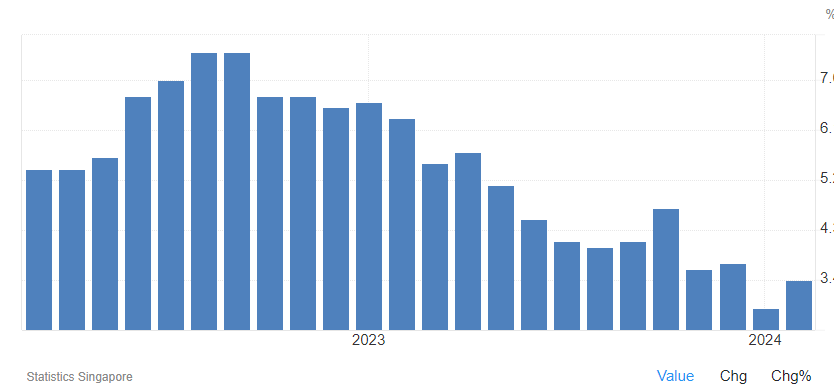Seeking Investments Opportunity as Loose Policy Halts SGD's Rise
Inflation in Singapore declined from a peak in September 2022 to 3.4% by February 2024. Despite a slight rise in February, above January's 2.9%, this was mainly due to increased costs during the Lunar New Year, including higher airfares, holiday expenses, and rising food prices. The Singapore Central Bank has kept its monetary policy steady for the third time in a row, expecting inflation to ease later in the year, suggesting potential further easing ahead.

Singapore Inflation Rate YoY
The MAS previously stated that "core inflation is likely to stay elevated early this year but will gradually decline and fall before the fourth quarter, then decrease further next year."
According to Bloomberg, the Singapore Central Bank may start easing policy as early as April. The Monetary Authority of Singapore (MAS) uses the exchange rate rather than interest rates as its primary policy tool, allowing the Singapore dollar to appreciate against the currencies of major trading partners to counter price pressures. As inflation shows signs of slowing, the strong rise of the Singapore dollar may end due to monetary easing.
Peter Chia, an FX strategist at UOB, has indicated that the Singapore dollar's strong performance could cease as the Monetary Authority of Singapore is expected to begin normalizing its monetary policy in April.

For investors in Singapore anticipating a decline in the Singapore dollar, it might be a good time to diversify into foreign assets. This strategy serves as a hedge against the potential devaluation of the Singapore dollar, as the relative value of foreign assets would increase if the local currency depreciates.
Uncertain Fed Moves Spur Interest in Intermediate-Term U.S. Bonds
According to Morningstar Direct, in early 2023, intermediate-term U.S. government bond funds drew a net inflow of $9.8 billion within two months.
In the first half of 2023, investors turned to short-term bonds for yield because of an inverted yield curve. As bets on interest rate cuts intensified in the second half of last year, investors moved towards long-term bonds, driving up their prices. Now, with the Fed set to cut rates but with persistent inflation, market expectations have adjusted from six anticipated cuts to three, altering U.S. bond market investment strategies again.
Thornburg portfolio manager Christian Hoffmann points out that markets should consider two other scenarios: if economic trends hold, there might be just one or no rate cuts. If economic data worsens, the number of cuts could rise to five or six. The U.S. bond market is caught between rate cut expectations, which benefit bonds, and the Fed's possible higher inflation tolerance, which doesn't.
Given this rate uncertainty, Hoffmann suggests that intermediate-term bonds (4 to 10 years) may be the best option, offering benefits from current higher yields while mitigating the risk of significant price drops compared to longer-term bonds.

Japanese Stocks' Rise Supported by Ongoing Policy Initiatives
On March 15, Rengo, Japan's major union, reported a 5.28% wage hike for large companies—the highest since 1991—which bolstered the Bank of Japan to end negative interest rates and Yield Curve Control on March 19, shifting to a zero rate policy. This marked the end of prolonged deflation. With policy normalization, the Nikkei 225 briefly exceeded 41,000 points on March 22.
Last year's AI boom became a driving force behind the rise in Japanese semiconductor stocks, which have maintained strong performance. In 2023, several Japanese semiconductor-related companies, including chip equipment giant $Tokyo Electron(8035.JP$ , test equipment manufacturer $Advantest(6857.JP$ , semiconductor production equipment maker $Screen Holdings(7735.JP$, wafer slicing machine producer $Disco(6146.JP$, and silicon wafer leader $Shin-Etsu Chemical(4063.JP$, have all reached new highs. In the latest revised budget for the fiscal year 2023, the Japanese government has allocated 2 trillion yen to subsidize the development of the semiconductor and generative AI industries.

The Tokyo Stock Exchange has been pushing for corporate governance reform, requiring companies to improve ROE or PBR to emphasize capital efficiency and shareholder returns. For example, $Idemitsu Kosan(5019.JP$ aims to raise its ROE from 8% to 10%, while $Suzuken(9987.JP$ plans to cut cross-shareholding rates. Both firms' stocks have surged about 50% in the past year.
The American asset management behemoth BlackRock has upgraded its forecast for Japanese stocks to "overweight." The company attributes this positive outlook to "moderate inflation, robust profit growth, and corporate governance reforms."
Sources: Bloomberg, Yahoo Finance, Nikki Asian, Trading Economics
Disclaimer: Moomoo Technologies Inc. is providing this content for information and educational use only.
Read more
Comment
Sign in to post a comment
